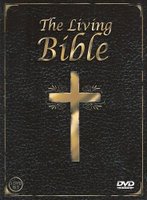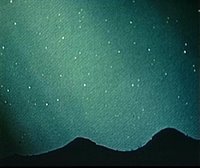Series Summary: UK Living Bible
 Over the last 3 months I've been working my way through the UK DVD release of the Living Bible Series. With 12 episodes each of around 15 minutes there's over 3 hours worth of material and I've commented on each episode as I've been going along. I wanted to offer a few overall thoughts however, particularly as earlier reflection have focussed more on the individual scenes than the series as a whole.
Over the last 3 months I've been working my way through the UK DVD release of the Living Bible Series. With 12 episodes each of around 15 minutes there's over 3 hours worth of material and I've commented on each episode as I've been going along. I wanted to offer a few overall thoughts however, particularly as earlier reflection have focussed more on the individual scenes than the series as a whole.The history of this series is a little complicated, and I'm grateful for the comments WitlessD made on one of the earlier previous posts on this subject which sum things up as well as anywhere I have found. The episodes included here are a selection from the original series which apparently consisted of 26 fifteen minute episodes. The films were originally released on 16mm film. Then in 1982 these were edited and shown on US TV as 12 half hour episodes. I'll be covering this release at some point in the future. The re-release merged episodes and used different titles and so on.
The UK DVD release returns to the original films and offers them in their original format. On the downside this does mean the quality is fairly poor. This is only to be expected though. The films were relatively rare and at no point does this claim to be a remastered or restored print. It does mean, however, that they come in their original format. They are the same length and have the same introductions and titles as that series. As the starts and ends of episodes are often narrated this is fairly significant.
 What is strange, however, is that the episodes are in such an unusual order. The 12 episodes released out of the original 26 are as follows:
What is strange, however, is that the episodes are in such an unusual order. The 12 episodes released out of the original 26 are as follows:1. Birth of the Savior (2)The numbers in brackets represent the number of that episode in the original series. It's apparent, then, that this release has it's episodes in a muddle. In some places this is fairly insignificant (e.g. the order of episodes 6 and 7 where one is unique to John and the other based on the synoptics). However in places the discrepancy is so glaring it seems amazing that it has been missed. For example, Jesus's appearance before the high priest after is betrayal in Gethsemane, or his ascension after his resurrection.
2. Childhood of Jesus (3)
3. Thirty Pieces of Silver (18)
4. Jesus and the Lepers (15)
5. First Disciples (5)
6. Jesus at Nazareth and Capernaum (7)
7. Woman at the Well (6)
8. Jesus Before the High Priest (21)
9. Betrayal in Gethsemane (20)
10. Trial Before Pilate (22)
11. The Lord's Ascension (26)
12. The Lord is Risen! (25)
 Jesus is played by Nelson Leigh who starred in a number of other religious films. Leigh's performance has to be measured against the era in which this series was recorded. Hollywood was still avoiding showing the face of Jesus on the silver screen (out of due deference to the waning Hayes Code). In fact it would be ten years before a major film depicted Jesus - Nicholas Ray's King of Kings (1961). In the meantime they would release a string of films that would only portray Jesus's back or his hand. So such an up close depiction was ground breaking for its time.
Jesus is played by Nelson Leigh who starred in a number of other religious films. Leigh's performance has to be measured against the era in which this series was recorded. Hollywood was still avoiding showing the face of Jesus on the silver screen (out of due deference to the waning Hayes Code). In fact it would be ten years before a major film depicted Jesus - Nicholas Ray's King of Kings (1961). In the meantime they would release a string of films that would only portray Jesus's back or his hand. So such an up close depiction was ground breaking for its time.Another issue which impinges on Leigh's performance is the overall quality of filmmaking. These are clearly low budget films and the writing is fairly unimaginative, making only a small amount of effort to understand the events and the characters it depicts. It's also a very literal rendering. Whilst it's happy to vary some of the dialogue (usually for brevity), it rarely offers incidents not recorded in scripture.
 Given all that, then, Nelson Leigh's performance is reasonably impressive. Whilst he offers very little emotion, he does bring some warmth to the character. There's a fatherliness to his Jesus, not unlike HB Warner in DeMille's The King of Kings (1927). Leigh smiles less than DeMille's Jesus, and his performance lacks some of Warner's nuances, nevertheless his performance rings more truly. Sandwiched between the Second World War and the Cold War Leigh's Jesus is about right for the early 1950s.
Given all that, then, Nelson Leigh's performance is reasonably impressive. Whilst he offers very little emotion, he does bring some warmth to the character. There's a fatherliness to his Jesus, not unlike HB Warner in DeMille's The King of Kings (1927). Leigh smiles less than DeMille's Jesus, and his performance lacks some of Warner's nuances, nevertheless his performance rings more truly. Sandwiched between the Second World War and the Cold War Leigh's Jesus is about right for the early 1950s.Elsewhere the acting is more uneven. Some performances are decent enough; others are hilariously poor. The actors are not helped by having to cover their heads with what certainly appear to have been tea towels, nor does the overall lack of character development in the script give them much to work with. Even so, most of the performances either fall flat or are over acted.
In a funny way this reflects the more visual aspects of the film. Generally, the compositions are uninspired, and the camera work is fairly static. Occasionally however, something a bit out of the ordinary is tried, perhaps a special effect. When they do, however they feel forced and awkward, particularly by today's standards.
 These criticism are perhaps a little harsh, particularly for an ultra low budget series, filmed just after the end of the war. As a visualisation of the gospel stories they are fairly solid even if they are a little stolid. The individual episodes work better than the film as a whole. Given that, at the time they were produced, few of these events had been re-created in talking film, then even a workmanlike portrayal such as this had a lot to offer. Without understanding that it would be easy to miss their importance, and in addition to this they have a certain charm. View an individual episode as a history piece and you'll probably get the most out of it. Anything else would be unfair.
These criticism are perhaps a little harsh, particularly for an ultra low budget series, filmed just after the end of the war. As a visualisation of the gospel stories they are fairly solid even if they are a little stolid. The individual episodes work better than the film as a whole. Given that, at the time they were produced, few of these events had been re-created in talking film, then even a workmanlike portrayal such as this had a lot to offer. Without understanding that it would be easy to miss their importance, and in addition to this they have a certain charm. View an individual episode as a history piece and you'll probably get the most out of it. Anything else would be unfair.Labels: Living Bible, Living Bible Jesus, UK Living Bible
































